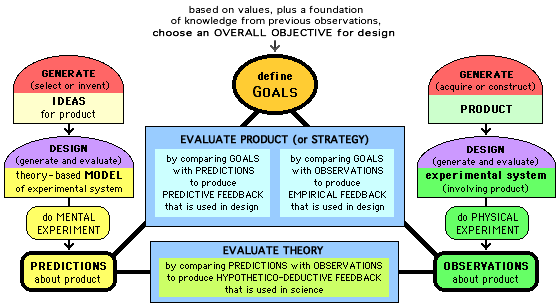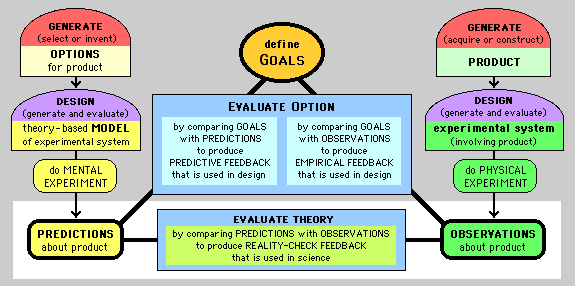Coping with Complexity
An Introductory Update
While writing this page in 2001, using
ideas I had been thinking about since 1993, I was motivated to develop
simpler methods for teaching design and science:
A model focusing on three elements
(goals, observations, predictions) is used in An
Introduction to Design and A
Brief Overview of Design. Another model with three elements
(observations, predictions, theory) is used in An
Introduction to Science. Relationships between these models
are examined in a page that compares Design
and Science to find their similarities and differences. Even
while using these simple models, however, strategies for "coping
with complexity" will be useful.
This page contains two sections:
Strategies for Effective Teaching, and Essential Tension in Models.
Strategies for Effective
Teaching
When a complex process (like
design or science) is described in a model (like IDM or ISM) there is a tension
between the conflicting criteria of simplicity and completeness. When
a model is more complete it allows a more accurate description, but the resulting
complexity can make the model less useful for education if students feel
overwhelmed and confused because too many concepts are presented too quickly.
But this potential difficulty can
be minimized — thus allowing a model to be used for teaching students
of different ages and experience, abilities and interest — if the
information content of the model is adjusted by simplification and enrichment. For
example, in two pages (Introduction to Design and Overview
of Design) IDM is described in two ways, using visual diagrams
(shown below) and verbal descriptions that vary in detail, beginning
with simplicity and building toward completeness and complexity.


Of course, these descriptions of design
could be further enriched by including more details in a diagram or description.
To help students cope with complexity
while you are helping them develop an understanding that is deeper and
more complete, a useful teaching tool is an isolation that
makes it easier for students to focus their attention on one part of
the IDM diagram. This can be done by using a special diagram that
has one part highlighted with a white background, as shown below, or
by using a regular diagram and covering everything except the part that
is the current focus of attention.

Isolations (with students
focusing on the "highlighted in white" part of the whole) can be
used in a whole-part-whole teaching method that
shifts back and forth between the whole diagram and isolations. Used
skillfully, this method will help students learn more about each part of
IDM and its relationship to other parts and to the whole, as they learn to
understand and appreciate the organized complexity of design. A whole-part-whole
approach is useful for gradually building complexity while avoiding an information
overload. It can also help students improve their ability to interpret
visual symbolism and to understand the logical relationships within complex
systems of concepts. Just as important, they can gain confidence in
their ability to cope with complexity.
Another principle for effective teaching
is to use IDM in the context of student actions and experiences. Instead
of lecturing about "design method" as an abstract concept that
students have little reason to care about, IDM can be an integral part
of students' personal experience. After they have worked on a design
project, a teacher can help them think about what they have done, why
it worked, and how they can improve it for their projects in the future. The
ideas in IDM should be connected with what students recently have experienced,
now are experiencing, or soon will experience. When a designing
activity is accompanied by a reflection
activity that encourages introspective metacognition, the combination
is more effective than either the designing or the reflection would be
by itself. Ideally, intrinsically interesting design activities
and reflection activities will be coordinated into a wide spiral curriculum
(as discussed in Part 2 of Problem Solving
in Education) that integrates design with science.
Strategies for effective teaching — such
as simplifying or enriching, building complexity in gradual steps, showing
whole-part-whole relationships, and connecting action with reflection — are
used daily by good teachers. Effective instruction of any type
requires wise "adjustment decisions" about selection and sequencing,
with the goal of maintaining an appropriate pace (not too slow, not too
fast) and level (not too easy, not too difficult) for the majority of
students in a classroom. The same sensitive awareness and improvising
skill that allows effective teaching in other areas will also make it
possible to teach effectively using IDM and ISM.
Essential
Tension in Models
When we try to represent a
complex process with a simple model, tensions are unavoidable.
In the early days of developing
ISM, when I showed people the ISM-diagram a
common criticism was that "It's too complicated, and students will
feel overwhelmed." My response to this valid concern, which
has influenced the subsequent development of ISM and then IDM, is based
on three principles:
First, the process of science is complex,
so an accurate model of science must be complex.
Second,
a model is a simplified representation of reality, and each model contains
many factors that can be adjusted
in an attempt to achieve various goals, as explained in Describing
Science using a Flexible Framework.
Third, in order to achieve common
educational goals we need effective teaching strategies for coping with
complexity, as discussed above.
This subsection examines the second principle,
the goal-directed construction of models. Let's imagine that, in a
series of case studies, we are analyzing fifty examples of problem solving
across a wide range of design and science. We will find that some core
actions occur in all cases, while some auxiliary
actions vary from one case to another. If we want to construct
a general model that is always applicable, we include only the core actions. But
for a model that allows a complete description of specific cases, we also
need auxiliary actions. Thus, our judgments about whether we have constructed
an optimally useful model will depend on how
we have defined our goals.
In a model, should we aim for maximum
generality, maximum specificity, or an optimal balance? And how
should we define optimality? When constructing models, it is often
difficult to achieve a balance between conflicting goals and the associated
conflicting criteria. And a desirable balance varies with context. A
good balance between simplicity and completeness will be different for
education in elementary school, high school, and college. And it
will differ for basic education and for scholarly research. ...
a note for the
reader: This subsection, which is being temporarily abandoned, will
eventually include the following topics:
• why I began with ISM and
then constructed IDM;
• why IDM is simpler than ISM
even though design is not simpler than science;
• relationships between generalizing,
core actions and simplicity, and between specificity, auxiliary actions,
completeness and complexity, and between all of these and the flexible
improvising (like a hockey skater, not a figure skater) discussed in Methods
for Problem Solving.
• viewing IDM (or ISM) as a "family
of models" differing in level of detail;
• defining "importance" in
two ways, for problem solving and for education;
• how generality and specificity
are related to transfer of skills.